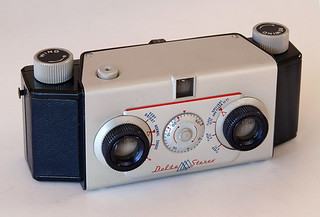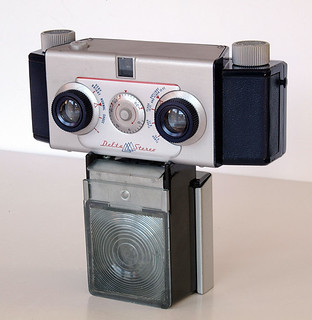Delta Stereo
| ||
| Delta Stereo images by Geoff Harrisson (Image rights) | ||
The Delta Stereo camera was made in 1955 by Lennor Engineering Co. in Chicago, Illinois, USA. Three published addresses were: 5614 North Clark Street,[1] 5612 North Clark Street[2] and 2632 West Barry Avenue.[3] It is a basic 35mm stereo viewfinder camera in roughly the Stereo Realist format, designed to make 3D images, which would be mounted as double slides and viewed with a special viewer, somewhat like a View-Master.
Contents
Physical description
The body was made in two variants: either metal with a blue enamel finish, or black plastic; both have panels of matching leatherette covering.[4] There are studs to attach the buttonholes of an old-style leather strap. The camera has a brushed aluminium faceplate, on which are the lenses, the window for the viewfinder and the frame counter.
The frame counter is an exposed dial on the front between the lenses, and must be set manually at the beginning of every roll. It counts down the remaining exposures.
Optics
The lenses are a matched pair of 50mm f/6.3 fixed-focus lenses, which would be normal lenses for full-frame 35mm, but are rather long for the Stereo Realist aspect ratio, which is 23mm by 25mm in portrait orientation.
It also has a basic viewfinder, the eyepiece of which rotates to unlatch the back plate of the camera, which tilts back and comes off completely. The back is not tight-fitting or sealed, and mild to severe light leaks can occur. The viewfinder has no correction for parallax, which becomes problematic inside about 5-7 feet.
| ||
| Delta Stereo images by Geoff Harrisson (Image rights) | ||
Aperture and shutter
Both lenses have rotating rings with labels that are fairly unclear by modern standards. The ring around the right lens adjusts the shutter speed, with descriptions of various lighting conditions. These settings correspond to speeds 1/100, 1/50, 1/25 and B.
Around the left lens are four settings marked in feet. This scale has been mistaken by some writers (including McKeown) for a focusing scale. This is not the case; the camera is fixed focus. The scale indicates the aperture settings to be used with the flash at the given ranges. These settings correspond to the non-standard stops f/6.3, 9, 12.7, and 18.
Red marks on both scales indicate a recommended daylight exposure for the original recommended film speed: f/6.3 at 1/50th of a second, or equal to daylight conditions at roughly 10-20 ASA. Information about shutter speed and aperture comes from the original manual, and is not guaranteed to be precise or accurate. The aperture is continually variable through its range.
The diaphragm is quite unusual. Each of the paired apertures has a "cat's eye" appearance, caused by two circular openings sliding past each other in opposite directions. At the highest stop, the aperture is little more than an almond-shaped vertical slit, while at the lowest it is almost perfectly circular. This design is apparently so that the two apertures can be more easily synchronized, as most of the parts travel in the same horizontal line.
The shutter is similar in this regard, being a simple guillotine shutter placed immediately behind the aperture. This shutter works like a focal plane shutter in miniature, having one rounded part that slides to the left (as seen from behind) to expose the film and another part with a correspondingly-shaped gap that slides over to meet it when the exposure is done. The whole mechanism slides back to the right with the cocking mechanism when the film is wound, and is then ready to be fired again. Almost all motion inside the camera is left-to-right and right-to-left, allowing the film to efficiently cock the shutter as it moves left-to-right across the film plane. As the film essentially drags the shutter mechanism along with it, there is no gearing or other reducing linkage to present resistance, and cocking the shutter is almost effortless.
The shutter release does two things when depressed: pressed halfway, it fires the shutter, and pressed fully, it releases the rack that grips the film. The rack then springs home to its original position and re-engages the film as soon as the button is released. Each winding advances the film ten perforations, making interlaced pairs of portrait-oriented 23x25mm frames (Stereo Realist format). Each stereoscopic pair has two frames between it, one from the previous pair, one from the next. This causes frames to be skipped at the beginning and end of a roll. The shutter release is held down during rewinding to release the film.
| ||
| Delta Stereo images by Geoff Harrisson (Image rights) | ||
Film and processing difficulties
Kodachrome K135 was the only film recommended in the manual (given the time period, this would likely be ASA 12 or 16), but an experienced photographer will have no difficulty using any film below about ASA 100 for daylight or higher for indoor shooting. Any ASA above about 200 will be unusable in direct daylight because of the low maximum shutter speed. Because the camera does not display this information, it may be helpful to make a chart that shows what camera settings correspond to what exposure times and f-stops.
Getting prints or scans made can be difficult if negative film is used, as the overwhelming majority of labs are not set up to automatically scan the unusual frame width. Some labs charge a fee for manually scanning film on the flat-bed, which is often required. This may be one of the reasons why slide film was so heavily associated with stereo cameras from this period, as cutting frames out and mounting them in pairs in special double slides is easier than blowing up irregularly-sized images and then printing the pairs side-by-side. However, shooting slide film (which has no latitude for wrong exposures) in this camera is likely to challenge even moderately advanced photographers.
Some send-away labs can fully process, digitize and even print stereo film for a fee. At least one send-away lab charges the same fee as for processing half-frame 35mm.
Flash
There is a flash contact in the base, adjacent to the tripod socket where a Delta bulb flash can be attached. This is apparently a fairly serviceable flash bulb unit for #5 or equivalent bayonet-mount bulbs, but unlike most contemporary units, it screws onto the tripod socket and hangs directly below the camera rather than sitting on top. The camera was also sold in a kit with the flash and a stereo viewer. A two-piece faux-leather carrying case was apparently sold separately. The case screws on via the tripod socket and protects the camera while making it more comfortable to hold. It is possible to photograph with the case open, and a tripod can even be attached via a second socket on the bottom of the mounting screw. The flash is unusable with the case, as the contact is inaccessible. There is a socket in the shutter release button for the pin of a standard cable release.
Conclusion
The Delta Stereo is extremely basic but serviceable to an experienced photographer who wants 35mm stereo but cannot obtain a Stereo Realist or similar. It does have the advantage of being basic enough that the photographer need not adjust multiple controls for each shot. A photographer who is good at judging light levels (or who possesses a hand-held meter) might leave the shutter speed at the maximum (to prevent motion blur and camera shake) and adjust the aperture alone, given slow enough film. As the camera does not need to be focused or cocked before taking a picture, it can be faster to use (if much less precise) than the Stereo Realist. It is also a decently compact camera which may be found with the case fairly readily, so it has the advantage of being easy to carry. The most glaring disadvantage seems to be the light leak on some or all examples, which can probably be remedied by putting electrical tape around the seam.
Technical specs
- Type: Stereo viewfinder camera, 35mm
- Manufacturer: Lennor Engineering Co., Chicago, IL.
- Lens: No-name 50mm f/6.7, matched pair
- Image format: 23x25mm interlaced stereo pairs.
- Filter thread: None
- Shutter: Dual horizontal guillotine/sliding shutter type, behind lens. Shutter speeds 1/100th-1/25th, B.
- Film transport: Knob, cocks shutter via sliding rack
- Exposure: Manual
- Viewfinder: Simple reverse-telescopic type
- Focusing: Fixed
- Flash: Proprietary bulb flashgun, mounted to contact on tripod socket
- Exposure Value range at ISO 100: 15-Infinity
Links
Notes
- ↑ Advertisement in “Popular Science” October 1955, page 62
- ↑ Delta instruction book
- ↑ Warranty registration card, July 1955
- ↑ McKeown, James M. and Joan C. McKeown's Price Guide to Antique and Classic Cameras, 12th Edition, 2005-2006. USA, Centennial Photo Service, 2004. ISBN 0-931838-40-1 (hardcover). ISBN 0-931838-41-X (softcover). Page 620.
| Companies of Chicago (Illinois) |
| Adams & Westlake | Central Camera Co. | American Advertising and Research Co. | Bernard | Burke & James | Busch | Calumet | Candid | Chicago Aerial | Chicago Camera Co. | Chicago Ferrotype Company | Deardorff | De Vry | Drucker | Galter | Geiss | Herold | Imperial | Kemper | Lennor Engineering Co. | Metropolitan Industries | Monarch | Montgomery Ward | Pho-Tak | QRS Company | Rolls | Sans & Streiffe | Sears | Seymour | Spartus | The Camera Man | United States Camera Co. | Western Camera Manufacturing Co. | Yale | Zar | Zenith |
| Chicago in depth: The Chicago Cluster, a bakelite trust? |


